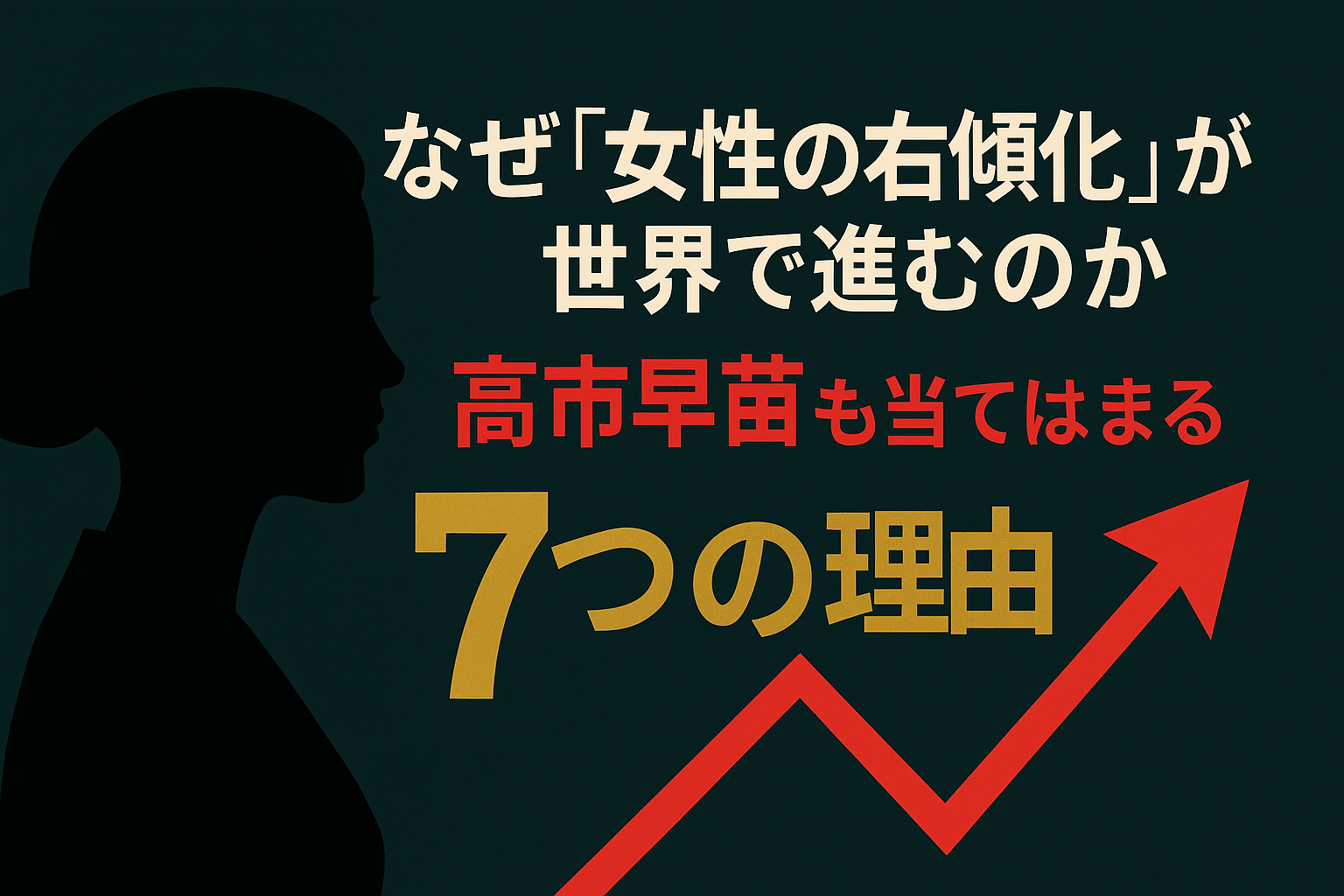なぜ「女性の右傾化」が世界で進むのか
——高市早苗も当てはまる“7つの理由”
本記事では、ニューヨークタイムズ中国語版で公開された「女性右翼领导人为何崛起?」を手がかりに、 女性リーダー台頭の背景を国際政治の視点から整理します。ニューヨークタイムズは英語・中国語・日本語(ワイヤー)など、 言語ごとに記事の構成や強調点を微妙に変えて配信するメディアとして知られています。 同じテーマでも、英語版が「グローバルな政治潮流」を中心に描く一方、中国語版では 「アジア政治の文脈」や「国際社会が女性リーダーをどう位置づけるか」にフォーカスが置かれるのが特徴です。 今回の中国語版記事もその典型で、高市早苗・メローニ・ルペンといった女性右派リーダーの背景を、 政治危機・政党組織・社会の期待の交差点として描き出しています。
■ 1. G7における「女性=右派」の顕著な偏り
近年、世界の政治で女性リーダーが目立つようになりました。
一見すると、ジェンダー平等が進展しているように見えます。
しかし、ニューヨークタイムズ中国語版の記事が強調するのは、その多くが右派・保守政党から生まれているという事実です。
G7諸国で女性トップを輩出した国の顔ぶれを並べてみると、この傾向はより明確になります。
英国ではサッチャー、メイ、トラスの3人がすべて保守党出身。
ドイツでは中道右派のCDUを率いたメルケルが長期政権を担いました。
カナダのキム・キャンベルは右派の進歩保守党(Progressive Conservative Party)の党首として首相を務め、
フランスでは社会党のエディット・クレスソンが例外的に短期間だけ首相に就任。
そして日本では、自民党の高市早苗氏が初の女性首相として選ばれました。
一方で、ジェンダー平等を標榜してきた左派・リベラル政党からは、G7レベルではほとんど女性トップが生まれていません。
つまり、「女性リーダー=進歩的」という直感的なイメージとは逆に、むしろ既存秩序が揺らぐ政治危機の局面で、右派が“女性というカード”を切っている構図が浮かび上がります。
■ 2. 女性リーダーは「政治的危機」の局面で登場しやすい
記事が次に注目するのは、女性リーダーが登場するタイミングの共通性です。
多くの場合、それは政治の混乱や経済危機、既存エリートへの不信が高まっている局面でした。
英国では、サッチャーは国内の経済停滞と社会不安のなかで保守党の立て直し役として台頭し、
メルケルは保守政権の汚職スキャンダル後に「クリーンな外様枠」として浮上しました。
メイはBrexit国民投票の混乱処理を引き継ぎ、ジョルジャ・メローニは長期にわたる政権交代と政治不信の積み重ねの後に選ばれています。
日本でも、高市早苗の登場は、
長期間の経済停滞と自民党支持率の低下という文脈を抜きには語れません。
政治システムが行き詰まりを見せたとき、
「既存とは違う象徴性」を帯びる女性リーダーが受け入れられやすくなる——
記事はこのような「危機の象徴としての女性」への期待が、各国で共通する傾向として存在すると指摘しています。
■ 3. 女性リーダーは必ずしも「進歩的」ではない
ここで重要なのは、女性リーダーの政治的スタンスが一枚岩ではない、という点です。
メルケルは難民受け入れで比較的リベラルな姿勢を示した一方で、
メローニや高市氏は国家アイデンティティや伝統的価値観を前面に掲げる保守政治家です。
高市氏の場合、日本の文脈における女性の置かれた立場を語りつつも、
夫婦別姓の維持や男系継承の正当性を強調する姿勢を示してきました。
これは、女性リーダーであっても必ずしも女性の権利拡張に向かうとは限らないことを示します。
むしろ記事が指摘するのは、女性が保守的な政策を掲げることで、
従来であれば社会から受け入れにくかった強硬な政策が
「柔らかいイメージのパッケージをまとって受け入れられやすくなる」側面もあるという点です。
「女性だから前に立っているのだから、そこまで極端ではないだろう」
という期待が、保守アジェンダを正当化する装置として働く場合もあります。
■ 4. 左派政党が女性トップを生み出しにくい理由
表面的には、ジェンダー平等を掲げてきた左派政党の方が、
女性リーダーを登用しやすいように見えます。
しかし実際には、状況はそれほど単純ではありません。
その背景には、「制度と党内文化のギャップ」が存在するためです。
比較政治学の研究によれば、
左派政党は長年にわたり「クオータ制」やジェンダー配慮政策を掲げて議員数を増やしてきました。
ところが、党内における最終的な意思決定ポジションには、依然として男性優位が続いています。
赤・緑の左派や社会民主系を含む広いネットワークの調査でも、
最終段階では女性が排除されやすいという傾向が確認されています。
その結果として、女性リーダーは、
むしろ保守・右派の政党から選ばれるケースが目立ちます。
「ジェンダー平等を掲げる政党」と
「実際に女性トップを生む政党」がズレている——
この記事が指摘しているのは、この皮肉な現実です。
■ 5. 就任直後の支持率が高く見えやすい理由(“ハネムーン効果”)
女性リーダーは就任初期に比較的高い支持を得やすい、
と指摘する研究は多く、政治学の枠を超えて繰り返し確認されています。
その理由の一つが、前任者との対比による「リセット効果」です。
交代が前任の男性リーダー対評的に映ることで、
新鮮さや「歴史的瞬間」としての期待が一時的に高まりやすくなります。
もう一つは、ジェンダー・ステレオタイプの作用です。
「柔らかさ・誠実さ・清潔さ」
といったイメージが女性リーダーに投影され、
メディアもその物語を好んで取り上げる傾向があります。
ただし、この期待は政策評価というより「象徴への期待」に近く、
長期の実務評価が始まると必ずしも維持できないリスクも抱えています。
「女性だから支持する」という段階を超えて、
具体的な政策と実績で評価する段階に進まなければ、
安定的な支持とは言えません。
■ 6. 高市早苗の登場をこの構図の中でどう位置づけるか
NYT分析を高市早苗に当てはめてみると、日本政治の現状がより立体的に見えてきます。
高市の登場は、
「女性だから突破した」のではなく、
「構造の変化に乗った」現象として捉えることができます。
日本では、長期的に男性中心の政治構造が続き、「女性トップ誕生」が遅れてきました。
その中で、「これまでとは違う象徴」が求められる局面もありました。
政治的な混乱が続いた時期、高市は保守路線の維持と安定性をアピールしつつ、
「女性だからこそ見える強さ」を組み合わせて訴えてきました。
安全保障に強硬姿勢を示し、歴史認識でも明確な立場を示す一方で、
「日本の象徴的な女性首相」というイメージ性を乗せた、
対外的にも国内的にも受け入れやすい“象徴パッケージ”として機能していると考えられます。
女性リーダーを評価する際に重要なのは、ジェンダーそのものではなく、
どのような政策パッケージを掲げ、どのような政治的構造の中から生まれてきたのかを
丁寧に分析することです。
――NYTの指摘は、まさに高市早苗の登場を日本政治の文脈に位置づけていると言えます。
■ 7. 結論――「女性リーダーの台頭」をどう読むべきか
記事全体の議論が示すのは明確です。
女性リーダーの台頭は、ジェンダー平等が進んだ結果として“自動的に”起きた現象ではありません。
むしろ、政治的な危機、政党内部の権力構造、社会の期待が変化することで生じた
「構造ではなく情勢的な産物」 として読む必要があります。
女性がトップに立ったからといって、社会が自動的に進歩するわけではありません。
状況によっては、既存の政策が受け入れやすくなったり、強硬な政策が
「これまでより柔らかい形」で正当化されることもあります。
高市早苗という日本初の女性首相候補をどう評価するかは、まさにこの構図に直結します。
焦点は 「性別そのもの」ではなく、どのような政策パッケージを掲げ、
どのような政治的情勢の結果として登場したのか にあります。
日本の有権者に求められるのは、
「女性だから」という期待や先入観ではなく、政策内容と権力配置そのものを
冷静に見極める視点です。
■ Primary Source
- The New York Times Chinese Edition.
「女性右翼领导人为何崛起?(Why Are Right-Wing Female Leaders Rising?)」, 2025年11月12日.
■ Key Academic References
- Keith, D., Gisselquist, R. M., Thomas, D., & Gains, F. (2016).
Left Parties and Women’s Representation in Europe.
掲載誌:Party Politics(SAGE Publications)
― 左派政党は女性議員を増やしながらも、党首職など象徴的権力では男性優位が続くことを指摘した研究。 - Dassonneville, R. (2021).
Female leader popularity and the vote, 1996–2016.
掲載誌:European Journal of Politics and Gender.
― 女性リーダーは平均して「好意的に評価されやすい」傾向があることを示した研究。 - Reyes-Housholder, C. (2020).
A theory of gender’s role on presidential approval ratings.
掲載誌:Political Research Quarterly.
― 女性リーダーは就任初期に比較的高い支持を得やすい可能性(ハネムーン効果)を示した論文。 - Miyazaki, K., Takayasu, M., & Takayasu, H. (2022).
Political honeymoon effect on social media: Characterizing reactions to prime minister changes in Japan.
arXiv preprint arXiv:2212.02827.
― 日本の首相交代時に、SNSデータからハネムーン効果(交代直後に肯定的反応が増えやすい現象)を実証した研究。
Why Right-Wing Female Leaders Are Rising Worldwide
— 7 Factors Behind the Trend
Why have so many of today’s most prominent female leaders risen from the political right rather than the left?
This article explores a pattern identified by the New York Times Chinese Edition—one that challenges the assumption that women’s political ascent naturally reflects progressive social change.
By situating Japan’s Sanae Takaichi within this wider global landscape, the analysis shows that the rise of female leaders is often driven less by gender equality itself and more by political crisis, party incentives, and shifting public expectations.
The seven factors below help explain why conservative or center-right parties have, paradoxically, produced more female leaders in many advanced democracies.
■ 1. A Striking Pattern in the G7: Women at the Top, Mostly from the Right
Over the past decade, women have become far more visible in global politics. At first glance, this seems like evidence of steady progress on gender equality. Yet the New York Times Chinese edition draws attention to a counterintuitive pattern: with one brief exception, every G7 country that has had a woman in its highest office did so under a conservative or center-right government.
Margaret Thatcher, Theresa May, and Liz Truss emerged from the UK Conservative Party. Angela Merkel came from Germany’s center-right CDU. Canada’s Kim Campbell belonged to the Progressive Conservative Party. France’s Édith Cresson, from the Socialist Party, served fleetingly and remains the outlier. Japan’s recent example, Sanae Takaichi, aligns once again with this conservative trend.
Left-leaning parties—despite their long-standing commitment to gender equality, diversity, and quotas—have produced virtually no female heads of government in the G7. This sharp divergence sets the stage for the broader analysis.
■ 2. Female Leaders Often Emerge in Moments of Political Crisis
The NYT highlights a shared pattern: women tend to rise to top leadership roles during moments of political turbulence or institutional fatigue.
Thatcher took office amid deep economic turmoil. Merkel inherited a party in crisis following the CDU donation scandal. Italy’s Giorgia Meloni rose in the aftermath of chronic fragmentation and widespread disillusionment. These moments created openings for leaders who symbolized rupture—even if their policies were firmly conservative.
In Japan, Takaichi’s ascent benefited from factional distrust and ideological recalibration within the ruling party. These are not stories of seamless progress; they are stories of political systems hitting their limits and turning to symbolic leadership as a reset.
■ 3. Female Leaders Are Not Necessarily Progressive
A crucial point is that women in power do not form an ideological bloc. Their political trajectories differ sharply.
Merkel, for example, adopted relatively liberal stances on migration during key periods. By contrast, Meloni and Takaichi foreground national identity, traditional values, and a hard security line.
Takaichi speaks about women’s isolation in politics, yet supports Japan’s single-surname system for married couples and prioritizes national security over gender reforms. These contradictions reveal that female leadership does not inherently advance women’s rights—and may, at times, reinforce conservative agendas.
More broadly, when women champion tough policies, their gender can soften public perceptions of those policies. A woman advancing a hardline agenda is often seen as less threatening than a man doing the same—an implicit political advantage.
■ 4. Why Left-Wing Parties Struggle to Produce Female Leaders
On the surface, left-wing parties—with their quota systems, gender platforms, and progressive ideals—seem more likely to elevate female leaders. In practice, the opposite occurs.
Comparative research shows a consistent pattern: left-leaning parties have increased the number of female legislators through institutional reforms. Yet the inner circles that decide top leadership remain dominated by long-standing male networks—union leaders, veteran strategists, and institutional gatekeepers.
Even in parties where women proliferate at the grassroots and mid-levels, the highest contests for power often consolidate around men. Surveys across European social democrats and greens show the same: diversity at the base does not always translate into diversity at the top.
As a result, women who do rise within left-leaning parties often come from more conservative or pragmatic factions—those comfortable with national security themes or fiscal restraint. This explains why the parties most vocal about gender equality rarely produce female leaders.
■ 5.Why Early Approval Ratings Tend to Be High (“The Honeymoon Effect”)
Another recurring dynamic is the “honeymoon effect”: female leaders often enjoy strong early approval ratings. This stems partly from a symbolic “reset” after male-dominated leadership and partly from gendered stereotypes—women perceived as cleaner, calmer, or more honest.
Media narratives amplify this, portraying new female leaders as a refreshing contrast to their predecessors.
Yet this goodwill is fragile. High expectations can quickly flip into disappointment if policy outcomes fail to match symbolic promise. Strong early approval numbers do not necessarily translate into long-term stability.
■ 6. Situating Sanae Takaichi in Japan’s Political Landscape
Through the lens of the NYT’s framework, Takaichi’s rise becomes clearer. Her ascent is not simply a story of “breaking through because she is a woman,” but rather the product of structural shifts inside Japan’s conservative establishment.
Japan’s political system has long been dominated by male networks, and the sudden appearance of a woman at the top carries significant symbolic weight. Takaichi’s political identity—rooted in conservative nationalism and hard security—fits neatly within the existing LDP architecture.
What distinguishes her is the fusion of this ideological posture with the symbolic currency of being Japan’s first female prime minister. The combination projects both firmness and novelty—a political package that resonates even with voters skeptical of hardline positions.
■ 7. What the Rise of Female Leaders Really Indicates
The overarching message of the NYT analysis is that the rise of female leaders is not a straightforward triumph of gender equality.
Instead, it reflects a convergence of political crises, shifting party incentives, public fatigue, and the search for new symbolic anchors in moments of institutional strain.
Women at the top can embody hope for change—but they can also make conservative agendas appear more palatable. Gender itself cannot predict whether a leader will be progressive or regressive.
Evaluating leaders like Sanae Takaichi, therefore, requires moving beyond gender and scrutinizing:
-
the political structures that enabled their rise
-
the agendas they advance once in power
For voters and analysts, clarity begins not with optimism or disappointment about “women in power,” but with an understanding of the deeper forces shaping when and why female leaders emerge.
■ Primary Source
- The New York Times Chinese Edition.
“女性右翼领导人为何崛起? (Why Are Right-Wing Female Leaders Rising?)”, November 12, 2025.
■ Key Academic References
- Keith, D., Gisselquist, R. M., Thomas, D., & Gains, F. (2016).
Left Parties and Women’s Representation in Europe.
Party Politics (SAGE Publications). - Dassonneville, R. (2021).
Female leader popularity and the vote, 1996–2016.
European Journal of Politics and Gender. - Reyes-Housholder, C. (2020).
A theory of gender’s role on presidential approval ratings.
Political Research Quarterly. - Miyazaki, K., Takayasu, M., & Takayasu, H. (2022).
Political honeymoon effect on social media: Characterizing reactions to prime minister changes in Japan.
arXiv preprint arXiv:2212.02827.






